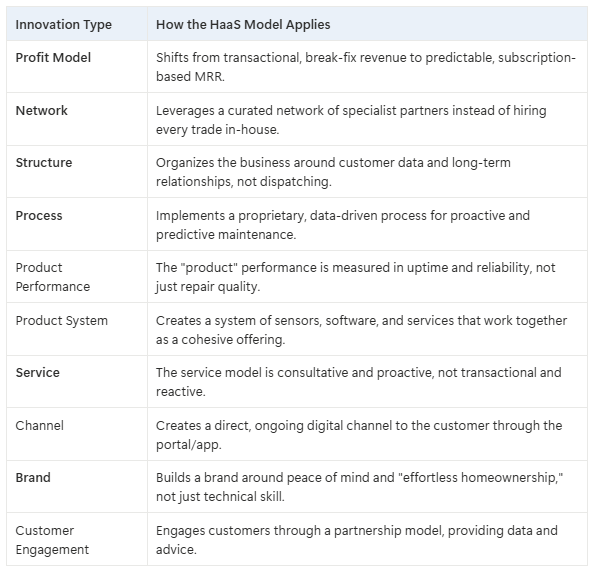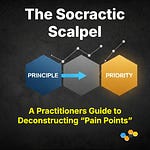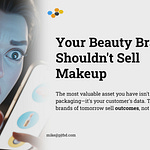Introduction: The Ticking Time Bomb in Home Services
Let's be honest. The experience of getting something fixed in your home is fundamentally broken. It’s a relic from a bygone era, built on a foundation of anxiety, uncertainty, and inefficiency. When your water heater dies or your AC gives out, you’re thrown into a reactive spiral of panic-Googling, vetting strangers based on a handful of questionable reviews, and bracing for an opaque, unpredictable bill.
The entire home services industry—from the solo plumber to the multi-state franchise—is built on a single, flawed premise: they make money when your life gets interrupted. Their business model thrives on your misfortune. It’s a transactional, adversarial relationship disguised with friendly logos and polo shirts.
For decades, we’ve accepted this as the only way. The "innovations" have been laughably incremental: better websites, online scheduling, GPS tracking on the van. These are thin veneers of modernity painted over a crumbling, 20th-century chassis. They’re focused on making a broken model slightly more convenient, not on building a new one that actually serves the homeowner.
This is where the real opportunity lies. Not in being a slightly better handyman, but in changing the entire game.
The future of home services isn't about fixing things faster. It’s about creating a world where things don't break in the first place. It's about shifting the paradigm from a reactive, break-fix model to a proactive, subscription-based "Home-as-a-Service" (HaaS) model. It’s about transforming your business from a seller of hours and parts into a manager of home system uptime and a seller of peace of mind.
What follows is not a collection of tips or tricks. This is the ultimate playbook for building a disruptive, scalable, and wildly valuable HaaS empire. We’re going to walk through a 7-step framework that will show you how to tear down the old model and build the future. This is your guide to stop being a firefighter and start being a home health doctor.
1. The Great Reframe: Elevating the Core "Job to be Done"
Before you can build a new solution, you have to stop and ask a brutally simple question: What business are you really in?
If your answer is "plumbing," "electrical," or "HVAC repair," you've already lost. Those are outputs, activities, and technical skills. They aren't the reason a customer hires you. No one wakes up in the morning excited to hire an electrician. They hire an electrician to get a job done. And if you don't understand that job at its deepest level, you'll be stuck competing on price and speed forever.
This is the core insight of the Jobs-to-be-Done (JTBD) framework. It posits that customers don't buy products or services; they "hire" them to make progress in their lives—to get a specific "job" done. Your real competition isn't just other service providers; it's any and every solution a customer could use to get that job done.
The first and most crucial step in building a HaaS empire is to reframe the job you're being hired for by elevating the level of abstraction.
Think of it as a hierarchy. At the very bottom, you have the immediate, obvious task.
The Task: "Fix my leaking pipe."
This is where 99% of the industry lives. The customer has a problem, you have a wrench, and the transaction is complete when the dripping stops. It's a low-value, commoditized exchange.
One level up, you have the functional job. What is the system this task is a part of?
The Functional Job: "Maintain the home's water distribution system."
This is a better perspective. It implies a broader scope. It's not just about one pipe; it's about ensuring the whole system—pipes, faucets, drains, water heater—works as intended. This is where preventative maintenance contracts live. But it's still clinical and functional.
Now, let's go one level higher. What is the real-life progress the customer is trying to make? What is the emotional driver behind it all?
The Aspirational/Emotional Job: "Ensure my family has a safe, comfortable, and functional home environment." or "Remove the anxiety and effort of homeownership."
This is it. This is the gold. No one cares about pipes and wires. They care about hot showers, light to read by, and a cool room on a summer night. They care about the feeling of security, of knowing that the complex, intimidating systems that run their home are being looked after. They want to offload the mental burden of being a homeowner.
When you define the job at this level, everything changes.
Your mission is no longer to "fix a leaking pipe." It is to "deliver a consistently functional home environment." You stop selling a one-time fix and start selling a continuous state of being. The leaking pipe isn't the job; it's a failure in your service delivery.
To get to this deep understanding, you have to talk to your customers differently. Stop asking them what they want. Instead, uncover the story behind the service call.
"Walk me through what was happening in your life when you first realized the AC was broken."
"What was the most frustrating part of that experience?"
"What did you try before you called us?"
"If you could wave a magic wand, what would the ideal experience of managing your home's systems look like?"
Listen for the verbs. People don't want a "diagnostic service" (your process); they want to "identify the source of a problem" (their job). They don't want a "new furnace" (your product); they want to "maintain a comfortable temperature in the home during winter" (their job).
When you elevate the job, you give yourself a much larger canvas to innovate on. You're no longer confined to the toolbox. You can now innovate on the business model, the customer experience, the technology, and the brand promise. You're not just a better handyman; you're an entirely new category of service provider.
2. First Principles Deconstruction: Tearing Down the "Handyman" Business Model
The traditional home services model is a fortress of assumptions—ideas we accept as "the way things are" simply because they've been around forever. To build something new, you can't just add a new coat of paint to that fortress. You have to take it apart, brick by brick, until you're left with nothing but the unshakeable foundation of truth. Then, you can build your empire.
This process is called First Principles Deconstruction. It's a methodical way of dismantling conventional wisdom to find what is fundamentally true, giving you a clean slate for innovation. It unfolds in four phases.
Phase 1: Preparation – Redefine the Core Problem
First, we must reframe the central question. The old model is built to answer this:
Loaded Premise: "How do we get more repair jobs and complete them efficiently?"
This question traps you. It assumes your business is about repair jobs. It forces you to think about marketing for distress purchases, optimizing technician routes, and stocking more parts on your trucks. It leads to incremental improvements on a broken model.
Let's reframe it from first principles, based on the elevated JTBD we just defined:
Neutral Reframing: "What is the most effective and customer-aligned way to deliver a functional, reliable, and safe home environment?"
This question is liberating. It doesn't mention trucks, technicians, or even repairs. It opens the door to completely different answers—answers that might not look anything like a traditional home service business.
Phase 2: Deconstruction – Systematically Refute the Foundational Assumptions
Now, we identify and challenge the core beliefs that prop up the entire break-fix industry. We will treat them not as facts, but as hypotheses to be stress-tested.
Assumption #1: "Value is created at the point of repair."
This is the central dogma of the industry. The moment of value creation is when the technician fixes the broken thing. The invoice reflects parts and labor for that event.
Refutation: This is a profound misalignment of incentives. It means you, the service provider, only make money when the customer suffers an inconvenience or a failure. The more their home breaks down, the better your business does. The customer's goal (zero failures) is in direct opposition to your revenue model (getting paid for failures). True value, from the customer's perspective, is uptime. It's the uninterrupted state of comfort and functionality. The repair is not the value; it's the penalty for a failure in delivering that uptime.
Assumption #2: "Customers are price-sensitive and want the lowest hourly rate."
The industry competes fiercely on price. Companies advertise low "service call" fees and focus on hourly rates, believing that's what drives customer decisions.
Refutation: Customers don't hate paying for a service; they hate unpredictability. The anxiety of a home repair bill comes from the unknown. "Is it a $200 fix or a $5,000 replacement?" This uncertainty is far more painful than a known, fixed cost. Research and behavioral economics show that people will consistently pay a premium for certainty and peace of mind over a lower but unpredictable cost. They don't want the cheapest hourly rate; they want the problem to go away with a predictable financial and emotional cost.
Assumption #3: "The primary business asset is skilled labor and physical equipment."
The old model views its assets as a fleet of vans, a warehouse of parts, and a roster of skilled technicians. Growth means buying more vans, hiring more techs, and leasing more warehouse space.
Refutation: This is a capital-intensive, low-leverage way to scale. It creates a linear relationship between investment and revenue. In the new model, the primary asset is the customer relationship and the data platform that manages it. The knowledge of a home's systems, its maintenance history, its real-time performance data—that is the asset. It creates a sticky relationship and a competitive moat that a van and a wrench cannot. The new model is asset-light, leveraging a platform to orchestrate services, not just own the labor.
Assumption #4: "Marketing is about being top-of-mind when something breaks."
The marketing playbook is SEO, Google Ads, and local service ads, all targeting keywords like "emergency plumber" or "ac repair near me." The goal is to be the first name a customer finds in a moment of panic.
Refutation: This is marketing to a customer at their most stressed and least loyal. It's a constant, expensive battle for attention at the bottom of the funnel. The new model doesn't market for emergencies; it markets a future state of being. It sells "effortless homeownership." The marketing isn't about being there when things break; it's about selling a subscription that ensures they don't. You're not selling a transaction; you're selling a transformation. This shifts the focus from lead generation to relationship building.
Phase 3: Validation – Identify the Fundamental Truths
After tearing down the assumptions, what are we left with? What are the irreducible, fundamental truths about this problem space that will not change?
Truth 1: Home systems are complex and degrade over time. This is physics. Mechanical and electrical systems have a finite lifespan and require maintenance to function optimally. This is a constant.
Truth 2: Homeowners fundamentally lack the time, specialized skill, or desire to manage these systems themselves. The trend is towards "do-it-for-me," not DIY. This specialization gap is widening, not shrinking.
Truth 3: Predictable, recurring costs are psychologically preferable to unpredictable, large-lump expenses. People subscribe to Netflix to avoid buying individual movies. They pay for insurance to smooth out catastrophic costs. The subscription economy is built on this psychological truth.
Truth 4: Data can be used to shift from reactive to proactive intervention. We now have the technology (sensors, IoT) to monitor system health and predict failures before they happen. It is now possible to know a water heater is about to fail before the customer does.
Phase 4: Synthesis – Rebuild from the Ground Up
Now, we synthesize these fundamental truths into a new foundation. This becomes the mission statement for our HaaS empire.
The New Foundation: "The winning home services model of the next decade will be a technology-enabled, subscription-based managed service provider for the home. It will use data to proactively maintain system uptime, delivering a state of effortless homeownership for a predictable monthly fee. Its core product is not repair; its core product is peace of mind."
With this new foundation, we are no longer iterating on the old model. We are ready to build something entirely new.
3. Architecting the Proactive Service Model: From Firefighter to Doctor
Armed with our new foundation, it's time to design the service itself. If you're no longer a reactive firefighter, what does it actually mean to be a proactive "home health doctor"? It means you architect your entire operation around prevention, monitoring, and long-term health, not emergency response.
This proactive model has several key layers:
The Onboarding & Home Health Assessment
The relationship with a new subscriber can't start with a broken appliance. It begins with a comprehensive "Home Health Assessment." This is your version of a patient's first physical. A senior "Home Health Manager" conducts a detailed, multi-point inspection of every major system in the home: HVAC, plumbing, electrical, foundation, roof, and appliances.
The output isn't a list of things to fix. It's a detailed report for the homeowner that includes:
The current health and expected lifespan of every major component.
A prioritized list of risks and recommendations.
A customized, proactive maintenance plan for the year.
This immediately reframes the relationship. You are not a repairman; you are a strategic partner and advisor in the long-term health of their most valuable asset.
The Technology-Enabled Monitoring Layer
This is where you build your defensible moat. The goal is to have insight into the home's systems even when you're not there. This doesn't have to be a sci-fi fantasy; it can be implemented pragmatically.
Simple Sensors: Start with simple, effective IoT sensors. Water leak detectors under sinks and behind washing machines. Smart smoke/CO detectors. Smart thermostats that provide HVAC performance data. These are inexpensive and provide immense value in preventing catastrophic failures.
Data Analysis: The data from these sensors, combined with the initial assessment, feeds into your platform. You're not just looking for alerts; you're looking for patterns. Is the HVAC unit running longer than it should for the current weather? That could signal an impending failure. Is a toilet's water usage subtly increasing? That could be a silent leak.
The Customer Dashboard: Give the homeowner a "single pane of glass"—a simple app or web portal that shows the health of their home. Not a bunch of complex data, but simple green/yellow/red indicators for each system. This makes your service tangible and constantly reinforces the value you're providing.
The Proactive & Predictive Maintenance Schedule
Based on the assessment and ongoing monitoring, you execute a schedule of proactive maintenance. This is the "doctor's check-up."
Scheduled Visits: Twice a year, a technician visits to perform routine maintenance: flushing the water heater, changing HVAC filters, cleaning coils, testing electrical outlets, etc.
Predictive Dispatch: When your data analytics flag an anomaly, you don't wait for the customer to call. You contact them proactively. "Hi Mrs. Jones, our system noticed your AC unit is running about 15% less efficiently than it was last month. We'd like to schedule a technician to come out and inspect it before it becomes a problem during the next heatwave." This is a magical customer experience.
Future Concept: The Self-Healing Home
This is where the model is headed. As smart home technology becomes more integrated, you can move beyond simple monitoring to automated resolution. Imagine a future where a smart water main detects a leak from a burst pipe and automatically shuts itself off to prevent flooding. Simultaneously, it sends an alert to your platform, which automatically dispatches the nearest on-call plumber with the details of the issue. The homeowner is notified that a problem was detected, mitigated, and a solution is already on the way—all without them lifting a finger. That is the ultimate expression of "effortless homeownership."
4. The Subscription Stack: Remastering the Profit Model with MRR
A proactive service model cannot survive on a transactional revenue model. The two are fundamentally incompatible. Trying to fund a preventative health service with emergency room billing would bankrupt a hospital, and it will bankrupt your HaaS business.
You must re-engineer your financials around Monthly Recurring Revenue (MRR). The subscription is not just a different way to bill; it's a strategic tool that aligns your incentives with your customer's. When a customer pays you a flat fee every month, your goal becomes delivering the promised "home uptime" for the lowest possible cost. This means you are now intensely motivated to prevent failures, perform efficient maintenance, and make smart, long-term repairs—the exact same things the customer wants.
Designing your subscription stack requires thoughtful tiering. A one-size-fits-all approach rarely works. Consider a "Good, Better, Best" model:
Tier 1: "Monitor" (The Digital Sentry)
Price: Low monthly fee (e.g., $25/month).
Service: This is your entry-level, tech-focused offering. It includes the initial Home Health Assessment and the installation of your core sensor package (water, smoke, temp). You provide 24/7 monitoring and proactive alerts. If a problem is detected, the customer is notified and can book a repair with you at a preferred (but still paid) rate.
Goal: This tier acquires customers and gathers data. It's a foot-in-the-door to demonstrate value and upsell them later.
Tier 2: "Maintain" (The Proactive Partner)
Price: Moderate monthly fee (e.g., $75-$150/month).
Service: Includes everything in "Monitor," plus the scheduled proactive maintenance visits (e.g., two per year). All standard maintenance tasks (filter changes, coil cleaning, etc.) are included. Repairs are still extra, but perhaps at a steeper discount (e.g., 15% off) and with priority scheduling.
Goal: This is your core offering for the average homeowner. It delivers on the promise of proactive care and is the workhorse of your business.
Tier 3: "Guarantee" (The Peace of Mind Promise)
Price: Premium monthly fee (e.g., $250+/month, possibly based on home size/age).
Service: Includes everything in "Maintain," but now all labor for repairs is covered. The customer only pays for parts (or you can even build in a "parts allowance"). This is essentially an insurance or home warranty model, but one that you control end-to-end. Because you've done the initial assessment and are managing the proactive maintenance, you can price this tier intelligently, unlike traditional home warranty companies that are underwriting a complete unknown.
Goal: This is for the high-end customer who wants to completely outsource the problem and is willing to pay a premium for total peace of mind.
This shift to MRR is a profound form of innovation. As outlined in Doblin's 10 Types of Innovation framework, innovating on your Profit Model is one of the most powerful and difficult-to-copy competitive advantages you can build. While your competitors are fighting for one-off jobs, you are building a predictable, scalable revenue machine with a customer lifetime value (LTV) that is an order of magnitude higher.
5. The Platform Play: Building the Home's Central Nervous System
Your proactive service and subscription model are the heart of your HaaS business, but technology is the central nervous system that makes it all work. In the old model, "technology" was a dispatch board and a phone number. In the new model, it's a sophisticated platform that creates value for you, your technicians, and your customers.
This isn't about having a flashy app for the sake of it. It's about building a system that creates a competitive moat—a system that gets smarter with every home you add and every data point you collect. Your platform needs to integrate three key experiences:
The Customer Portal (The "Single Pane of Glass")
This is the customer's window into their home's health and your service. It must be radically simple and reassuring.
Core Features: A home health dashboard (the green/yellow/red system status), a history of all service visits and reports, easy scheduling for future appointments, and a simple way to contact their dedicated Home Health Manager.
Strategic Value: This portal makes your service tangible. It's a constant reminder of the value you're providing, reducing churn and building loyalty. It replaces the anxiety of the unknown with the comfort of being informed.
The Technician App (The "Mobile Command Center")
Your technicians are no longer just "repairmen;" they are mobile data collectors and relationship managers. Their app needs to empower them to be both.
Core Features: Their daily schedule of proactive maintenance visits, a complete history of every client's home (including the initial assessment, past repairs, and known risks), digital checklists for standardized maintenance tasks, and the ability to easily order parts and generate reports on-site.
Strategic Value: This ensures a consistent, high-quality service experience on every visit. It arms your techs with the context they need to be true advisors, not just order-takers. ("Mrs. Jones, I see from your file that your water heater is 12 years old. While it's running fine today, we should probably start planning for a replacement in the next 18-24 months.")
The Admin Backend (The "Mission Control")
This is your operational brain. It's where you manage your customers, analyze data, and optimize your business.
Core Features: A CRM to manage your subscriber base, a dispatching and scheduling engine, a dashboard for monitoring incoming data from home sensors, and an analytics suite to identify trends (e.g., "This brand of dishwasher tends to fail after 5 years," or "Homes in this neighborhood have hard water issues").
Strategic Value: This is where you generate your proprietary insights. This data allows you to price your "Guarantee" tier more accurately, predict part needs for better inventory management, and continuously improve your proactive maintenance checklists.
This integrated platform strategy touches on several of Doblin's 10 Types of Innovation. You are innovating on your core Process (how you deliver service), your Structure (how you organize and use data), and the Platform itself becomes a product. This is how you build a business that is incredibly difficult for a traditional, non-tech-native competitor to replicate.
6. The Human Element: Rebranding the Technician and the Promise
You can have the best technology and the most innovative business model in the world, but your HaaS empire will fail if your customer-facing team is still operating with a break-fix mindset. The single most important cultural shift you must engineer is the transformation of the "technician."
In the old world, the technician is a functional expert. Their value is in their ability to diagnose and repair a specific piece of equipment. Customer interaction is often secondary and transactional.
In the Home-as-a-Service model, the technician becomes a "Home Health Manager."
This is not just a semantic change; it's a fundamental redefinition of the role. A Home Health Manager has two primary responsibilities:
Ensure System Health: This is their technical function. They perform the assessments, the proactive maintenance, and the necessary repairs with a high degree of skill.
Manage the Customer Relationship: This is their advisory function. They are the human face of your brand. Their job is to build trust, educate the homeowner, and provide proactive advice. They are more like a family doctor than a walk-in clinic surgeon.
To cultivate this new role, you need to rethink your hiring, training, and incentives:
Hiring: You're no longer just hiring for technical skills. You're hiring for empathy, communication, and a consultative mindset. You might find that someone with a background in high-end hospitality or client management, who you can train on the technical aspects, is a better fit than a master technician with poor social skills.
Training: Your training program must dedicate as much time to communication, active listening, and consultative selling as it does to technical procedures. Role-play scenarios where they have to explain a complex issue in simple terms or present a long-term capital plan for a customer's home.
Incentives: The old model often incentivizes technicians to upsell expensive, immediate repairs. Your new model should incentivize customer retention and satisfaction. Link bonuses to a technician's portfolio of clients' retention rates, their customer satisfaction scores (NPS), and their success in getting customers to follow through on proactive recommendations.
This focus on the human element directly impacts two more of Doblin's innovation types: Service and Brand.
Your Service is no longer defined by response time, but by the quality of the advice and the trust you build. The signature moments of your service are not the emergency repairs, but the calm, quarterly review where a Home Health Manager walks a client through their home's performance.
Your Brand promise shifts from "We'll fix it fast" to "Effortless homeownership." You're not selling repairs; you're selling a lifestyle. A lifestyle where the homeowner doesn't have to waste their precious mental energy worrying about the complex systems that support their life. Your brand becomes a synonym for reliability and peace of mind.
7. The Ecosystem Strategy: Scaling Beyond Your Four Walls with a Network
As you build your HaaS business, you'll face a critical strategic choice: do you try to do everything yourself? Should you hire master plumbers, electricians, HVAC techs, roofers, and appliance repair specialists, putting them all on your payroll?
For most, the answer is a resounding no. That is the path of the old model—a capital-intensive, operationally complex nightmare that is incredibly difficult to scale.
The truly disruptive play is to become the central platform in a curated ecosystem. You don't need to employ every trade; you need to master the customer relationship and orchestrate the delivery of specialized services through a trusted, vetted network of partners.
This is the Network innovation in Doblin's framework, and it's how you scale rapidly and flexibly.
Here’s how to build it:
Define Your Core Competency: Your in-house team should focus on the highest-frequency, most data-rich services. This is likely the Home Health Manager role—the generalist who performs the assessments, the routine maintenance, and minor fixes. They are the relationship owners.
Build a Curated Partner Network: For specialized, less frequent trades (e.g., roofing, major electrical work, foundation repair), you don't hire employees; you build a network of the top 1-3 specialist companies in your service area.
Create a Win-Win Proposition: Why would these top-tier specialists want to partner with you? Because you offer them something incredibly valuable:
A Steady Stream of Qualified Work: You're not sending them tire-kickers. You're sending them qualified, non-emergency jobs from your subscriber base.
Zero Customer Acquisition Cost: They don't have to spend a dime on marketing or sales for the work you send them. You handle all of it.
Better Project Management: Your platform provides them with the full history and diagnostic information of the home, making their job easier and more efficient.
Enforce Quality Through Your Brand: These partners operate under your brand's umbrella. They must adhere to your code of conduct, your communication standards, and your customer service protocols. You handle the billing, the scheduling, and the follow-up. To the customer, it's a seamless experience delivered by your company. You take a percentage of the job cost in exchange for providing the work and managing the experience.
This ecosystem model gives you incredible leverage. You can expand into new service categories without hiring a single new specialist. You can scale your business's revenue without proportionally increasing your fixed costs and operational headcount. You become the trusted gatekeeper, the "Intel Inside" for the home.
Novel Concept: The HaaS Marketplace
Looking further into the future, this model could evolve into a full-fledged marketplace. Imagine a platform where homeowners can subscribe to your core "Monitor" service, and then access a competitive, vetted marketplace of your network partners for any work they need done, all managed through your app. You become the operating system for the home, creating value for homeowners and trade professionals alike.
Conclusion: Your Empire Awaits
We've covered a lot of ground, but the core message is simple: the home services industry is standing on a precipice, and the break-fix model is about to fall. The forces of consumer expectation, technological capability, and business model innovation are converging to create a once-in-a-generation opportunity.
This 7-step playbook is your map to capitalizing on that opportunity. Let's recap the journey:
Elevate the Job to be Done: Stop selling repairs and start selling effortless homeownership.
Deconstruct from First Principles: Tear down the flawed assumptions of the old model to build on a new foundation of truth.
Architect a Proactive Service: Shift from being a firefighter to being a home health doctor, focused on prevention and uptime.
Remaster the Profit Model: Move from transactional revenue to the predictable, aligned power of MRR.
Build a Platform: Create a technology moat that delivers value to customers, technicians, and your operations.
Rebrand the Human Element: Transform your technicians into trusted Home Health Managers who are the face of your brand.
Scale Through a Network: Leverage an ecosystem of specialist partners to grow faster and more efficiently than any traditional competitor.
Notice how these steps create a virtuous cycle. A clearly defined job informs a proactive service, which can only be funded by a subscription model, which is best managed by a technology platform, delivered by consultative technicians, and scaled through a network. It’s a complete, interlocking system.
This isn't just a better business model; it's a multi-faceted innovation. By following this playbook, you're not just making one type of change; you're creating a composite of several, making your business incredibly resilient and difficult to copy.
Doblin's 10 Types of Innovation: The HaaS Model
The path forward is clear. While your competitors are busy printing flyers and optimizing their Google Ads for "emergency repairs," you can be building a machine. A machine that generates recurring revenue, builds deep customer loyalty, and creates a defensible, scalable platform.
The era of the handyman is over. The era of the Home-as-a-Service empire has just begun.
;substacFollow me on 𝕏: https://x.com/mikeboysen
If you're interested in inventing the future as opposed to fiddling around the edges, feel free to contact me. My availability is limited.
Mike Boysen - www.pjtbd.com
De-Risk Your Next Big Idea
Masterclass: Heavily Discounted $67
My Blog: https://jtbd.one
Book an appointment: https://pjtbd.com/book-mike
Join our community: https://pjtbd.com/join












